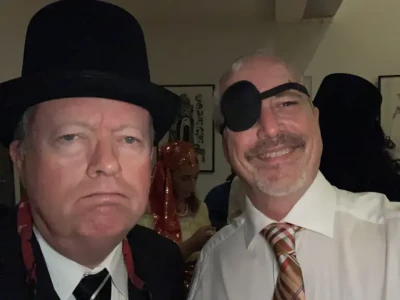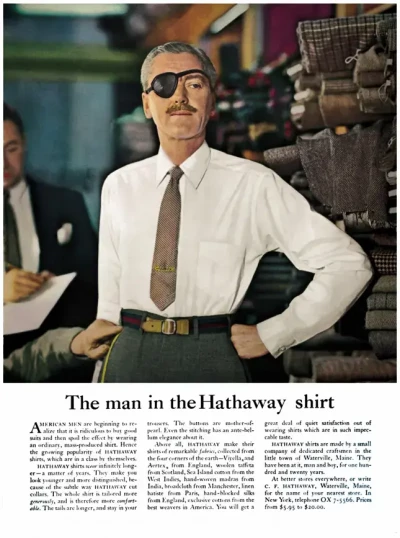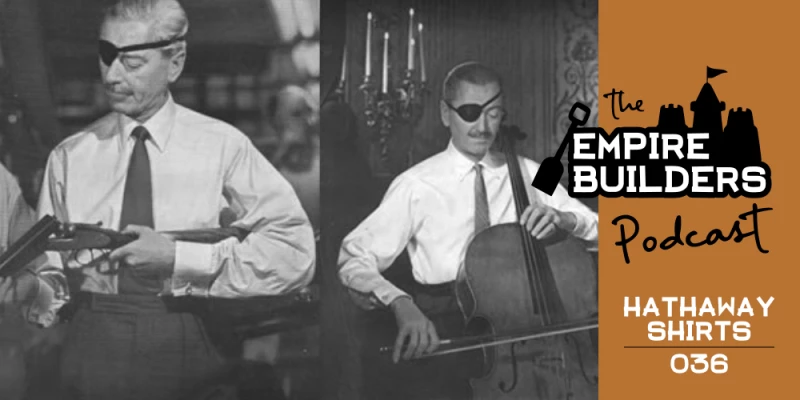Hathaway shirt ads, the picture makes you read the headline, encouraging you to read the first line of body copy. The first line of copy makes you read the next and so on. The secret that David Olgivy leveraged to make Hathaway rich.
Subscribe: Apple Podcasts | Google Podcasts | Amazon Music | Blubrry | RSS | More
Dave Young:
Welcome to the Empire Builders podcast, teaching business owners the not so secret techniques that took famous businesses from mom and pop to major brands.
Stephen Semple, I was excited when you told me that today, we were going to talk about the Hathaway shirt ad campaign. David Ogilvy. If you’re in the advertising business, like we are, he’s one of the giants whose shoulders we like to stand on because he was just an amazing ad guy with some amazing ideas and some weird ways to put things into a campaign that I think you’re probably going to talk about here in the Hathaway campaign. It was so cool and so different.
Stephen Semple:
 And you know, we’re advertising and marketing guys is about time. We talked about a campaign, and look great advertising campaigns have contributed to the building of business empires. There’s absolutely no question about that. And David Ogilvy was incredible. And I would actually recommend people grab this book, Ogilvy on Advertising. It is an amazing bunch of examples of really great ads and how he thought about the ads. And part of what gave me the idea on this is not so long ago, I was in Los Angeles and I was in Los Angeles at Halloween. And I got invited to this swanky Halloween party. And it had a theme and the theme was come as your favorite celebrity. And I thought, oh my God, what am I going to do? And I’m flying. So I want it to be something that’s easy to pack. So I decided I’m a marketing advertising guy. I’m going to go as the Hathaway shirt guy. So what I put on and there’ll be pictures in the show notes of these ads. So what I put on nice crisp white shirt, I found a retros 1950 tie, because it is 1950 campaign, and an eye patch. Done, I’m the Hathaway shirt guy. One person in the audience got it. There’s a buddy of mine who is there, Clint Arthur., And he’s also in the marketing business. He was like, “Hathaway shirt?” I was like, yes.
And you know, we’re advertising and marketing guys is about time. We talked about a campaign, and look great advertising campaigns have contributed to the building of business empires. There’s absolutely no question about that. And David Ogilvy was incredible. And I would actually recommend people grab this book, Ogilvy on Advertising. It is an amazing bunch of examples of really great ads and how he thought about the ads. And part of what gave me the idea on this is not so long ago, I was in Los Angeles and I was in Los Angeles at Halloween. And I got invited to this swanky Halloween party. And it had a theme and the theme was come as your favorite celebrity. And I thought, oh my God, what am I going to do? And I’m flying. So I want it to be something that’s easy to pack. So I decided I’m a marketing advertising guy. I’m going to go as the Hathaway shirt guy. So what I put on and there’ll be pictures in the show notes of these ads. So what I put on nice crisp white shirt, I found a retros 1950 tie, because it is 1950 campaign, and an eye patch. Done, I’m the Hathaway shirt guy. One person in the audience got it. There’s a buddy of mine who is there, Clint Arthur., And he’s also in the marketing business. He was like, “Hathaway shirt?” I was like, yes.
So when I was in university, I studied the crap out of David Ogilvy and this is something I don’t do today. It’s the same studying of older campaigns and David Ogilvy I just loved, I studied all of his stuff. He was my big marketing hero. So that’s the reason why I felt it was appropriate it for me to go as that character. But here’s the other interesting thing with that ad. So we’re going to talk about the ad. It’s also like all of these ideas. Guess what? It’s been copied a bunch of times.
Dave Young:
Sure.
Stephen Semple:
It’s been copied a number of times. Here’s a little bit of the history behind this campaign. So it’s 1951 and Ellerton Jette is running this 115 year old shirt company called Hathaway shirts in Waterville, Maine. And he wanted to turn this little company into a national brand. That was his dream.
And so he’s one of our guys. He wanted to build an empire, right? He decided he wanted to hire David Ogilvy. And David Ogilvy was big, but not huge yet, but still he wanted to hire him. He had saw his work, but it was going to be a tiny deal. He knew he needed to really persuade Ogilvy on this. So here’s what he did, goes to Ogilvy and he says, “If you take on the job, Mr. Ogilvy, I promise you this, no matter how big my company gets, I will never fire you. And I will never change a word of your copy.”
Dave Young:
Right.

Stephen Semple:
That’s a dream client. And for everyone listening copy is the words in the advertising. So he basically said, I’ll never fire. You do whatever the hell you want. I’ll run all your ads. And it works. We’ve seen that done before. So remember the Old Spice, the original Old Spice that completely revived the Old Spice brand.
Dave Young:
Sure. I’m on a horse.
Stephen Semple:
Yeah. I’m on a horse. Well, that campaign was run by, and I’ll have to look it up, but I’ll put it in the show notes, it slipped my mind now.
Dave Young:
Wasn’t Wieden and Kennedy.
Stephen Semple:
That’s it. You’re right.
Dave Young:
They’re one of those Maverick ad agencies, I think located in Portland.
Stephen Semple:
Yeah. And for years, P&G wanted to use them for a campaign. But what they always said is we’ll work for you, but don’t change our stuff. And finally, P&G approached them with Old Spice. So you know how we’ve talked in the past running experiments, this was a bit of experiment because they were ready to shut Old Spice down.
Dave Young:
Yeah.
Stephen Semple:
They were ready to shut down. They said, what the heck? We’ll let you guys run a campaign. And the deal was you change nothing. And they ran this campaign and Old Spice catapulted back into the top of their category.
Dave Young:
Yeah. Yeah.
Stephen Semple:
So this way of approaching ad guys and going, you know, I’m going to change. Nothing totally works and actually is how you get great work out of them. It’s that hire the expert, listen to the expert. It’s the HBO story again, right?
Dave Young:
Yeah.
Stephen Semple:
They ran the Hathaway shirt campaign. And what they did is the first insertion was in The New Yorker.
Dave Young:
These are print ads.
Stephen Semple:
Print ads and they spent $3,176 to run this ad in The New Yorker. And it was an instant success. It was editorial mentioned in Time and Life and Fortune. The New Yorker did a cartoon of three men looking into display window of a shirt store. And the next panel, they’re all pitcher coming out of the store, wearing eye patches. They didn’t buy the shirt. Eye patches, we don’t know whether sales of eyes patches went up.
But what we do know is within a week you couldn’t find a Hathaway shirt in New York City. They were sold out everywhere. So it was this huge, huge, huge success. Here’s what’s really interesting. What Ogilvy talks about in his book is the picture, so when you’re looking at print ad and look, this works for the web as well. Picture makes you read the headline. The headline makes you want to read the first sentence. The first sentence makes you want to read the paragraph. And he had copy like this. “The gun is a $2,000 Purdy from England,” right? The shirt is a sea island cotton from Hathaway, right? And then it goes on to say this. So here’s what some of the copy sounds like, “the sea island cotton is astounding stuff with fibers three times longer than ordinary cotton. It is described in advertisements as soft as swans down, lustrous satin, an absorbent wool and as durable as line, it has grown in St. Vincent, Antigua, in Kits and Montserrat. Then it travels. But between being plucked in the balmy Caribbean sunshine and its final hypothesis on a shirt made by Hathaway, Maine, this cotton has been to England and back.”
My favorite is how he says, “it is described in advertisements.” Like this is not an ad, right. It’s described in advertisements this way.
Dave Young:
Yeah.
Stephen Semple:
So the man could write this great copy and you read this copy and it took you on this journey, but what he knew was he needed a picture to catch the attention. Oh and by the way, if you don’t think this type of copy still works, read a Peterman catalog.
Dave Young:
Oh, absolutely. Right. There’s there’s, there’s no way Peterman wasn’t influenced by Ogilvy.
Stephen Semple:
Absolutely. And up until that day, the ads were always about the shirt. Not about the man.
Dave Young:
Yeah.
Stephen Semple:
And these pictures and some of this copy, there’d also be other copy talking about the man. And what was fabulous was he built around this image of this distinguished man and this series of really interesting and glamorous locations and always dressed in a Hathaway shirt and describe like this it’s different. It was original. This was the first time that an advertising shirt focused as much on the man wearing the shirt as the shirt itself.
And so what they would do is they would picture them in romantic locations and they gave these ads, all these fictional elements and really created the story and Ogilvy was a flamboyant dresser. So, and he got, actually got the idea of the eye patch from a photo he had seen of Ambassador Lewis Douglas who had injured his eye while fishing in England. And he sort of thought, boy, this might make it more distinguished and whatnot. So on the way to the shoot, Ogilvy stops at a five and dime store and bought a few cheap eye patches. But he still wasn’t sure whether the idea was right. So he let the photo shoot happen. And then at the end of the photo shoot, while the photographer and everybody got all the pictures that they liked, he said, “You know what, could you just humor me? Just take a couple pictures of this and I’ll go away and you can just humor me and do this.”
Dave Young:
Yeah.
Stephen Semple:
And when the pictures came back, Ogilvy was like, “Nope, there’s something, there’s something special in this shot. There’s something intriguing about this guy with a patch on.” Ogilvy understood mystery and intrigue.
Dave Young:
Yeah.
Stephen Semple:
And what he understood was they never talked about the eye patch. They never explained the eye patch.
Dave Young:
But as you said, the picture makes you read the headline. The headline makes you read… and the picture has this guy in an eye patch. Nobody uses a model with an eye patch.
Stephen Semple:
Right.
Dave Young:
Right. And so you go, well, I wonder what this is about?
Stephen Semple:
Yeah.
Dave Young:
And it just draws you into the copy. It’s an amazing little sneaky trick. It makes the guy interesting enough that you want to know this story.
Stephen Semple:
Yeah. And then you want to be like him, don’t you want to be the most interesting man in the world, Dave?
Dave Young:
Well, you want to be interesting enough that maybe people would read a paragraph about you.
Stephen Semple:
Yeah. But don’t you want to be the most interesting man in the world?
Dave Young:
Of course.
Stephen Semple:
The Dos Equis beer ads, right?
Dave Young:
Yeah.
Stephen Semple:
They’re a rip off of this idea. If you take a look at a lot of the copy, a lot of the copy is very similar. That ad inspired the Dos Equis beer ad, which went on to be massively successful. And in fact, even how Goldsmith, the actor who played the most interesting man in the world, even how he got that part was playing this game of doing something different. So he showed up and what they were given was this last line to read. “And that’s how I wrestled Fidel Castro.” And they were asked to do an improvisation and he looked around and he saw all these young, good looking guys. And he said, “You know what, I’m going to do something completely different.” What he did. He walked up, he took off one of his socks and then improvised for 30 minutes around the sock before reaching the concluding line. And everybody was like, “Wow, there’s something really interesting about that guy.”
Dave Young:
You’ve never seen somebody with an eye patch where you didn’t think, I wonder what happened. Right?
Stephen Semple:
I wonder what happened. And great ads, you know, Hathaway went on to have a huge success. Unfortunately when the textiles industry changed and things along that line and after they moved on from Ogilvy after 20 some odd years, unfortunately it went into decline, but in their heyday Hathaway shirts or one of these shirts to have and-
Dave Young:
And the brand is still around. Yeah.
Stephen Semple:
Yeah. And you go back and again we talk about these ads that inspired Dos Equis, it inspired Bazooka Joe, but the real thing here is, do something to create some mystery and intrigue, do something stand out and then write a copy that takes people on a journey that makes you interesting and your shirts interesting. And ends up becoming that conduit to it.
Dave Young:
It can be something that’s just as random as an eye patch.
Stephen Semple:
Yes.
Dave Young:
That’s the amazing thing about putting what we call some kind of a third gravitating body, some kind of a weird ingredient in that’s not expected. It just increases the intrigue level.
Stephen Semple:
Yeah. So I encourage people to go and do some research on that ad and also research other inspiring ads. And I want to share this. This is the last thought I want to share. Last night, I was reading the book Shoe Dog, which is Phil Knight’s book. So he’s the one who founded Nike shoes and we’re absolutely going to do an episode on Nike shoes. It’s an incredible story, but here’s one of the things that Knight wrote in his book. “This, I decided this is what sports are, what they can do. Like books, sports, give people a sense of having lived others’ lives, of taking part in other people’s victories and defeats. When sports are at their best, the spirit of the fan emerges with the spirit of the athlete and in that convergence, in that transference is the oneness that the mystics talk about.” Dude, that’s what great advertising does. Great advertising, transports somebody to this different place and makes them want to live in that world. That is glamor. That is advertising. That is great literature. That is sports. That is how you move the needle.
Dave Young:
Thanks for listening to the podcast. Please share us. Subscribe on your favorite podcast app and leave us a big fat juicy five star rating and review at Apple Podcast. And if you’d like to schedule your own 90 minute empire building session.
- How’d The Bananas Build a Million-Person Waitlist? - July 2, 2025
- Innovation or Iteration? Spin Master’s Paw Patrol Playbook - June 23, 2025
- Lip Bar – Think big, start small. It’s better to fail than regret. - June 16, 2025

